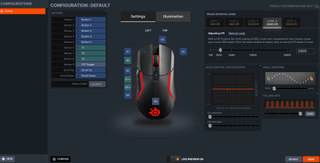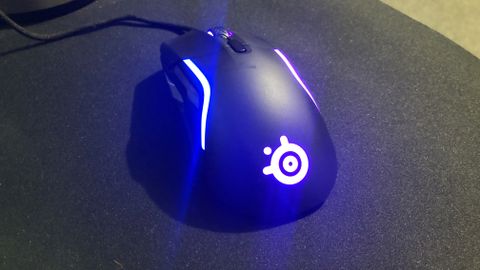Our Verdict
A well-priced gaming mouse, featuring an exciting button layout... which ends up not working so well in practice.
For
- Price
- Cool RGB design
- Mostly useful side buttons
Against
- Bad thumb button placement
- Heavy for a competitive gaming mouse
PC Gamer's got your back
I've got a question for you. If you use a gaming mouse with extra buttons in a competitive game and your opponents don't, does that count as cheating? I mainly ask because after using the SteelSeries Rival 5 gaming mouse, I feel like I might be cheating during Call of Duty. I definitely feel at an advantage, at least.
The Rival 5's best and worst features are the five quick action side-buttons (nine programmable in total). I don't mind a couple of side mouse buttons, but some gaming mice tend to overdo it by crowding a bunch of buttons that become awkward to use in practice. The Razer Naga X puts four rows of buttons right where you rest your thumb, for example.
The Rival 5 tries to find a better way to give you 9 programmable buttons that aren't in the way, and it mostly gets it right.
To be fair, the Naga gaming mouse targets MMO and MOBA players who have a reliance on a ton of hotkeys. The Rival 5 is geared towards battle royale games where the goal is never having your fingers move from the WASD keys unless they have to. World Of Warcraft PvP players might find a couple of well-placed buttons useful for saving precious milliseconds during an intense battlegrounds match.
The problem with a lot of gaming mice, however, remains one of button placement. The more you add, the more creative you have to be about where to put them. The Rival 5 has a clever workaround by adding a slim up/down padding above two (also slim) thumb buttons. So now you can map four actions on technically three buttons.




Price: $60
Sensor: TrueMove Air sensor,
Sensitivity: 18k dpi
Programmable Buttons: 9
LEDs: Customizable RGB (10 zones)
Cable length: 6 feet Super Mesh cable
Weight: 0.3 oz (85g)
The oversized silver side button is the only button with questionable placement. I appreciate it not being directly where I rest my thumb yet it does sit slightly out of reach, making it difficult to use during gaming.
Even with a palm grip, the silver button is in an awkward position. I'm actually a claw grip guy, and I found myself having to give my thumb a hell of a stretch. I don't think it would be an issue for folks with larger hands and longer thumbs—are long thumbs a thing? For my dainty digits, however, it wasn't a great fit.
I do like the placement of the side paddle and the two long, slim buttons underneath it. It's useful having an area for your thumb to sit without worrying about accidentally hitting a button in a frantic firefight in Apex Legends.
SteelSeries offers a few smart recommended button mapping templates (which more companies should do) for games such as CoD: Warzone, World of Warcraft, and Fortnite. Yeah, you could just map whatever works, but it was good to see what SteelSeries thought the best for popular multiplayer games.
Offloading commands for armor plates and grenades to the mouse side buttons did make my life so much easier in Warzone, even if it did take a few rounds for my muscle memory to take over. I even tried mapping some build commands onto the mouse in Fortnite and found myself actually enjoying playing it; a game I often do poorly at because I'm so crap at building towers.

The Rival 5 sits at 85g, which is not the lightest, but it does feel like it can take some abuse. As much as I love using a 60g super light gaming mouse, you can't help but think one good squeeze could break the damn thing. If you feel the same way, but the extra weight is more of a concern for you, SteelSeries' Prime line of gaming mice might be more up your alley.
SteelSeries has used the TrueMove Air sensor as the optical sensor for the latest Rival mice, the same one it is currently using in its Prime series gaming mice, and that tracks fairly well for a gaming mouse under $100.
The SteelSeries GG app controls the Rival 5's very bright RGB lighting, and you can expect all the usual RGB controls to customize it to how you see fit from within the app. The app provides a high level of customization for each of the zones too. The RGB accents on each side give the Rival 5 a nice level of personality and I always like it when the RGB on a gaming mouse doesn't just end up getting covered by your palm.
While I agree with the design philosophy of having all those extra buttons on the Rival 5, their usefulness slips when one of them sits a little out of reach. Despite that one weird button locale, however, the SteelSeries Rival 5 is a solid gaming mouse for competitive gaming.
Another big plus is the mouse is only $60, and considering all the features you have out of the box, it's a hell of a good price. It's just that those extra buttons alone aren't enough to make this a particularly exceptional mouse; it's solid, but little more.
A well-priced gaming mouse, featuring an exciting button layout... which ends up not working so well in practice.

Jorge is a hardware writer from the enchanted lands of New Jersey. When he's not filling the office with the smell of Pop-Tarts, he's reviewing all sorts of gaming hardware, from laptops with the latest mobile GPUs to gaming chairs with built-in back massagers. He's been covering games and tech for over ten years and has written for Dualshockers, WCCFtech, Tom's Guide, and a bunch of other places on the world wide web.
